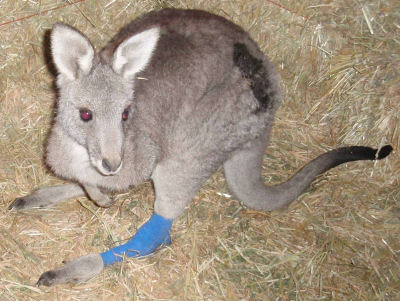Young injured 'roo, "Majura Malcolm", rescued from Majura site killings, now recovering
RSPCA inspections at Majura Firing Range
I have now received answers to the questions I put to the ACT RSPCA on 19 May 2009 regarding their welfare oversight of the recent killing of 3900 kangaroos at the Majura site by the Department of Defence. Below I list the questions asked and the answers received. Keep in mind this killing program began on Tuesday 5 May and ended by order of the Tribunal on Wednesday 13 May 2009 (my original letter is attached). Also keep in mind that in our meeting with Parliamentary Secretary Mike Kelly on 18 May he said he relied heavily on RSPCA advice that the kangaroos were starving and in the implementation of the Code of Practice for the Humane Destruction of Kangaroos in the ACT.
Question one:
On what days, at what times and for what lengths of time were representatives of the RSPCA in attendance at the site before and during this period (ie the period 5 May 2009 to 13 May 2009)?
Answer:
One visit only, Thursday 24 May, 2007, 1.30pm to 3.30pm
[NB: Actually, 24 May 2009 is a Sunday (but they say they went there in 2007), and as the killing took place between 5 and 13 May 2009 this means they actually visited the site two years ago or if they got the year wrong they went there two weeks after it had finished and a week after I wrote to them! So they either went to Majura two years before the killing or two weeks after it had finished! Either way its just extraordinary].
Question two:
Detail on procedures these representatives used to ensure that: (a) the kangaroos were suffering starvation; and (b) the killing that was carried out under the Defence program was ‘humane’ according to the Animal Welfare Act and the ACT Code of Practice for the Humane ‘Destruction’ of Kangaroos.
Answer:
The purpose of the visit was to discuss the proposed management program and to observe the general state of the grasslands and any kangaroos present at the time. Procedures were limited to general observations. No killing or other interventions with kangaroos were observed.
[NB: part (a) of the question is not answered so we can only conclude there was no issue of starvation of kangaroos witnessed otherwise it would have been mentioned. Their remit extends only to the condition of the kangaroos and not the condition of the grasslands. Part (b) was not observed, so which animal welfare authority provided oversight that the Code of Practice was adhered to?]
Question three:
In relation to your answer to Q2, please outline the following:
(a) Did RSPCA representatives travel across the entirety of this large site, or were inspections restricted to particular areas? If the latter please detail which specific areas were visited for inspection purposes.
(b) What sample size of kangaroos was used to draw conclusions about the entire population?
(c) Were qualified veterinarians in attendance at this time?
(d) Was any video footage or photographs taken before and during the kill program by RSPCA inspectors/ representatives?
(e) What percentage of kangaroos was killed in the first instance by a single ‘head shot’?
(f) What method of killing did your inspectors observe for ‘pouched’ kangaroo joeys? What happened to the at-foot joeys?
(g) How many contractors were used in the killing process and what was their level of expertise/ qualifications for the task?
(h) What types of firearm were observed by your inspectors being used by contractors used to kill the kangaroos?
(i) Was the contracted killing undertaken by night spotlight and rifle shooting of free-ranging animals or were other methods (e.g. rapid-fire weapons, corralling of animals etc). used?
(j) If the kangaroos were confined in any way, how long had they been confined for? What type of fencing was used? Did the kangaroos have access to adequate supplies of food and water? Were the kangaroos exhibiting obvious signs of stress?
(k) Has your organisation been given a schedule of numbers of kangaroos killed during the period including a demographic profile (male/ female adult, juvenile, ‘pouched’ young)?
(l) Is the killing continuing? Are the health and the stress levels of the remaining kangaroos being monitored?
Answer:
No representatives of the RSPCA have been in attendance at the Majura Training Area during the culling period and we do not have any information on the status of the culling program or the monitoring of kangaroos at the site.
Comments:
The two immediate comments from this reply are: (1) Which organisation is monitoring the welfare aspects of the culling of kangaroos as it is clearly not the RSPCA?; (2) Why did Mike Kelly tell Mark Drummond and myself at our meeting with him on 18 May that he relied heavily on RSPCA advice that the kangaroos at Majura were starving?
Prof. Steve Garlick
BA, MCom (Econ), PhD, FAUCEA


Comments
Tigerquoll
Wed, 2009-06-17 10:52
Permalink
What does RSPCA CEO Heather Neil have to say about this?
Vivienne (not verified)
Wed, 2009-06-17 21:25
Permalink
Public has been fed lies to justify Majura kangaroo massacre
Anonymous (not verified)
Fri, 2009-06-19 00:35
Permalink
not starving
Vivienne (not verified)
Mon, 2009-06-22 18:55
Permalink
The AAT don't have power over the status quo!
tractor (not verified)
Sat, 2009-06-27 11:46
Permalink
Supporting RSPCA is supporting Corruption - animal control for $
Add comment